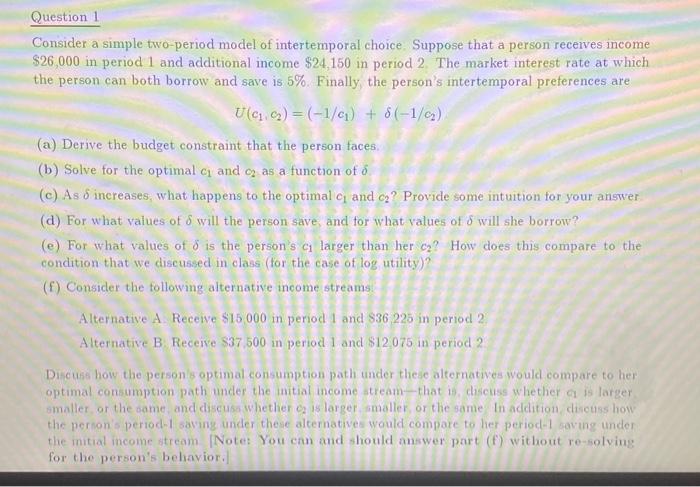Answered step by step
Verified Expert Solution
Question
1 Approved Answer
please answer d, e, f Consider a simple two-period model of intertemporal choice. Suppose that a person receives income $26,000 in period 1 and additional
please answer d, e, f 
Consider a simple two-period model of intertemporal choice. Suppose that a person receives income $26,000 in period 1 and additional income $24,150 in period 2. The market interest rate at which the person can both borrow and save is 5%. Finally, the person's intertemporal preferences are U(c1,c2)=(1/c1)+(1/c2) (a) Derive the budget constraint that the person faces. (b) Solve for the optimal c1 and c2 as a function of (c) As increases, what happens to the optimal c1 and c2 ? Provide some intuition for your answer (d) For what values of will the person save, and for what values of will she borrow? (e) For what values of is the person's c1 larger than her c2 ? How does this compare to the condition that we discussed in class (for the case of log utility)? (f) Consider the following alternative income streams. Alternative A Receive $15,000 in period 1 and $36,225 in period 2 Alternative B. Receive $37,500 in period 1 and $12.075 in period 2 Discuss how the person soptimal consumption path under these alternatives would compare to her optimal consumption path under the initial income stream-that is. discuss whether a is larger smaller, or the same, and discusa whether c2 is larger smaller, or the same In addition discuss how the perion's period-1 saving under these alternatives would compare to her period-1 gaving under the initial income stream. [Note: You can and should answer part (f) without re-solviug for the person's behavior. Consider a simple two-period model of intertemporal choice. Suppose that a person receives income $26,000 in period 1 and additional income $24,150 in period 2. The market interest rate at which the person can both borrow and save is 5%. Finally, the person's intertemporal preferences are U(c1,c2)=(1/c1)+(1/c2) (a) Derive the budget constraint that the person faces. (b) Solve for the optimal c1 and c2 as a function of (c) As increases, what happens to the optimal c1 and c2 ? Provide some intuition for your answer (d) For what values of will the person save, and for what values of will she borrow? (e) For what values of is the person's c1 larger than her c2 ? How does this compare to the condition that we discussed in class (for the case of log utility)? (f) Consider the following alternative income streams. Alternative A Receive $15,000 in period 1 and $36,225 in period 2 Alternative B. Receive $37,500 in period 1 and $12.075 in period 2 Discuss how the person soptimal consumption path under these alternatives would compare to her optimal consumption path under the initial income stream-that is. discuss whether a is larger smaller, or the same, and discusa whether c2 is larger smaller, or the same In addition discuss how the perion's period-1 saving under these alternatives would compare to her period-1 gaving under the initial income stream. [Note: You can and should answer part (f) without re-solviug for the person's behavior 
Step by Step Solution
There are 3 Steps involved in it
Step: 1

Get Instant Access to Expert-Tailored Solutions
See step-by-step solutions with expert insights and AI powered tools for academic success
Step: 2

Step: 3

Ace Your Homework with AI
Get the answers you need in no time with our AI-driven, step-by-step assistance
Get Started


